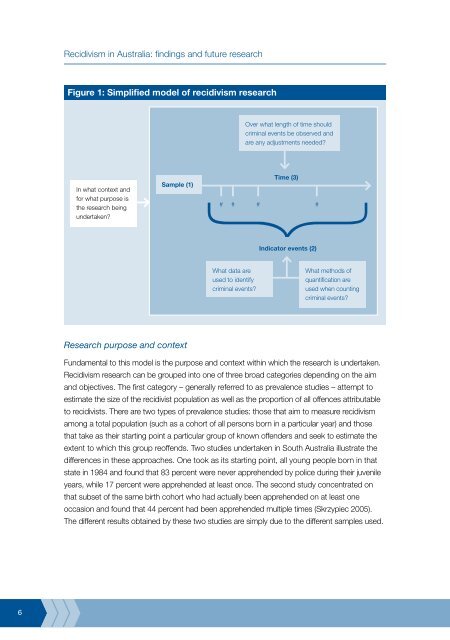Recidivism in Australia : findings and future research - Australian ...
Recidivism in Australia : findings and future research - Australian ...
Recidivism in Australia : findings and future research - Australian ...
You also want an ePaper? Increase the reach of your titles
YUMPU automatically turns print PDFs into web optimized ePapers that Google loves.
6<br />
<strong>Recidivism</strong> <strong>in</strong> <strong>Australia</strong>: f<strong>in</strong>d<strong>in</strong>gs <strong>and</strong> <strong>future</strong> <strong>research</strong><br />
Figure 1: Simplified model of recidivism <strong>research</strong><br />
In what context <strong>and</strong><br />
for what purpose is<br />
the <strong>research</strong> be<strong>in</strong>g<br />
undertaken?<br />
Sample (1)<br />
Research purpose <strong>and</strong> context<br />
#<br />
Time (3)<br />
# # #<br />
What data are<br />
used to identify<br />
crim<strong>in</strong>al events?<br />
Over what length of time should<br />
crim<strong>in</strong>al events be observed <strong>and</strong><br />
are any adjustments needed?<br />
Indicator events (2)<br />
What methods of<br />
quantification are<br />
used when count<strong>in</strong>g<br />
crim<strong>in</strong>al events?<br />
Fundamental to this model is the purpose <strong>and</strong> context with<strong>in</strong> which the <strong>research</strong> is undertaken.<br />
<strong>Recidivism</strong> <strong>research</strong> can be grouped <strong>in</strong>to one of three broad categories depend<strong>in</strong>g on the aim<br />
<strong>and</strong> objectives. The first category – generally referred to as prevalence studies – attempt to<br />
estimate the size of the recidivist population as well as the proportion of all offences attributable<br />
to recidivists. There are two types of prevalence studies: those that aim to measure recidivism<br />
among a total population (such as a cohort of all persons born <strong>in</strong> a particular year) <strong>and</strong> those<br />
that take as their start<strong>in</strong>g po<strong>in</strong>t a particular group of known offenders <strong>and</strong> seek to estimate the<br />
extent to which this group reoffends. Two studies undertaken <strong>in</strong> South <strong>Australia</strong> illustrate the<br />
differences <strong>in</strong> these approaches. One took as its start<strong>in</strong>g po<strong>in</strong>t, all young people born <strong>in</strong> that<br />
state <strong>in</strong> 1984 <strong>and</strong> found that 83 percent were never apprehended by police dur<strong>in</strong>g their juvenile<br />
years, while 17 percent were apprehended at least once. The second study concentrated on<br />
that subset of the same birth cohort who had actually been apprehended on at least one<br />
occasion <strong>and</strong> found that 44 percent had been apprehended multiple times (Skrzypiec 2005).<br />
The different results obta<strong>in</strong>ed by these two studies are simply due to the different samples used.















